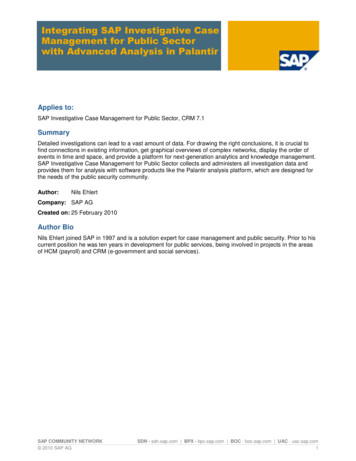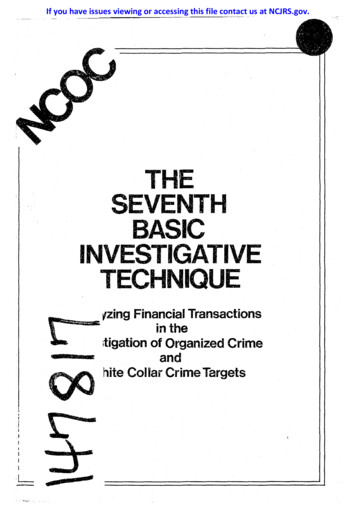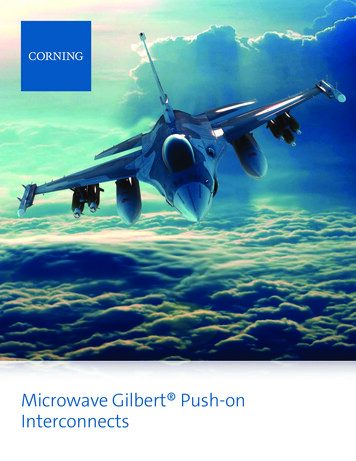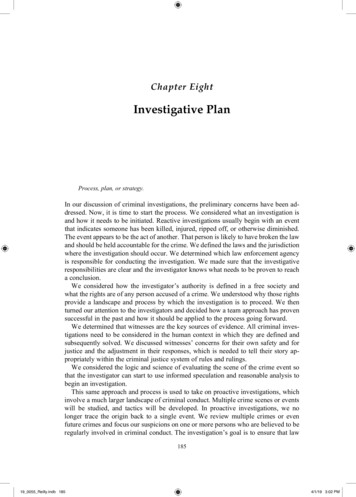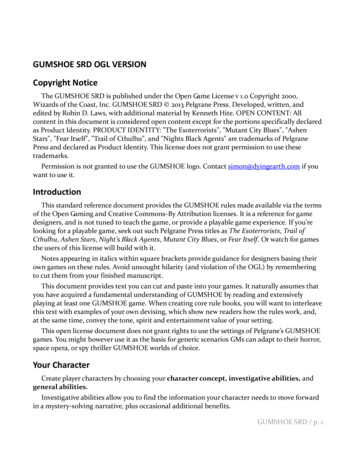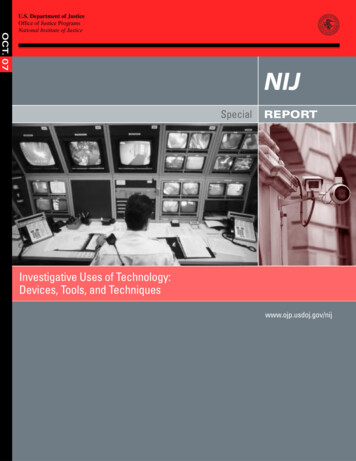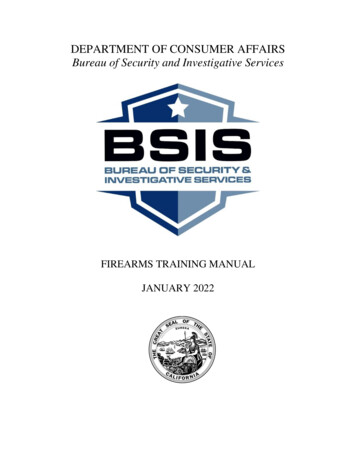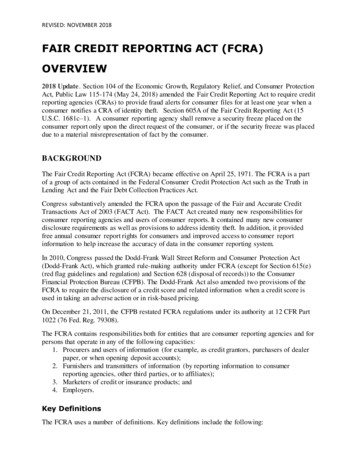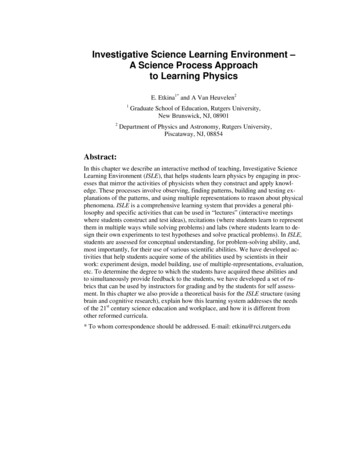
Transcription
Investigative Science Learning Environment –A Science Process Approachto Learning PhysicsE. Etkina1* and A Van Heuvelen212Graduate School of Education, Rutgers University,New Brunswick, NJ, 08901Department of Physics and Astronomy, Rutgers University,Piscataway, NJ, 08854Abstract:In this chapter we describe an interactive method of teaching, Investigative ScienceLearning Environment (ISLE), that helps students learn physics by engaging in processes that mirror the activities of physicists when they construct and apply knowledge. These processes involve observing, finding patterns, building and testing explanations of the patterns, and using multiple representations to reason about physicalphenomena. ISLE is a comprehensive learning system that provides a general philosophy and specific activities that can be used in “lectures” (interactive meetingswhere students construct and test ideas), recitations (where students learn to representthem in multiple ways while solving problems) and labs (where students learn to design their own experiments to test hypotheses and solve practical problems). In ISLE,students are assessed for conceptual understanding, for problem-solving ability, and,most importantly, for their use of various scientific abilities. We have developed activities that help students acquire some of the abilities used by scientists in theirwork: experiment design, model building, use of multiple-representations, evaluation,etc. To determine the degree to which the students have acquired these abilities andto simultaneously provide feedback to the students, we have developed a set of rubrics that can be used by instructors for grading and by the students for self assessment. In this chapter we also provide a theoretical basis for the ISLE structure (usingbrain and cognitive research), explain how this learning system addresses the needsof the 21st century science education and workplace, and how it is different fromother reformed curricula.* To whom correspondence should be addressed. E-mail: etkina@rci.rutgers.edu
Etkina & Van HeuvelenISLETable of Contents1. Introduction.41.1. The ISLE – helping students learn to do science .41.2. In what courses can it be used? .42. A brief description of ISLE: How does it work in a classroom? .52.1. The ISLE sequence used in concept construction consistently mirrorsscientific practice.52.2. ISLE is different from many reformed curricula – students’ original ideas arenot elicited at the beginning of instruction in a unit.72.3. ISLE emphasizes multiple representations at all stages of conceptconstruction .72.4. ISLE treats language carefully .72.5. New approach to assessment: focus on scientific abilities in addition tocontent .82.6. ISLE in your class: planning of one cycle.82.7. Assessment of student learning .103. An example of how ISLE works in one unit: circular motion .114. Our motivation and theoretical base: Why does ISLE emphasize scientificabilities, multiple representations, and specific pedagogical strategies? .174.1. The needs of the 21st century workplace: what do students need for successin their future lives and for success in the science workplace? .184.2. Scientific epistemology: how do scientists acquire knowledge?.224.3. Brain research: how does a human brain create, store and accessknowledge?.244.4. Cognition - how do people learn and change conceptions? .265. Cognitive apprenticeship: how to structure a learning environment to help studentsacquire cognitive skills?.286. ISLE implementation: available materials, support, and pitfalls .306.1. What materials are available for those who want to implement ISLE?301. The Physics Active Learning Guide (Student Edition) .31Research-Based Reform of University Physics2
Etkina & Van HeuvelenISLE2. The Physics Active Learning Guide (Instructor Edition). .323. The ISLE Laboratory Program .324. A set of ISLE Video Experiments.325. Higher-level thinking formative assessment activities .346.2. ISLE users can get support in many ways.346.3. Frequently asked questions about implementing ISLE .347. Evaluation of ISLE: Does the system work?.377.1. Traditional instruments: .377.2. Non-traditional instruments.378. Summary.399. Acknowledgments .40References.40Research-Based Reform of University Physics3
Etkina & Van HeuvelenISLE1. Introduction1.1. The ISLE – helping students learn to do scienceAs instructors, how do we create an environment in which students can discover andlearn physics for themselves - to own it, so to speak? In this chapter we describe aninteractive method of teaching—Investigative Science Learning Environment (ISLE),a Science Process Approach that addresses this question 1 . There are two key featuresof this approach. One feature involves students’ development of their own ideas by(a) observing phenomena and looking for patterns,(b) developing explanations for these patterns,(c) using these explanations to make predictions about the outcomes of testingexperiments,(d) deciding if the outcomes of the testing experiments are consistent with thepredictions, and(e) revising the explanations if necessary.Another key feature is encouraging students to represent physical processes in multiple ways, thus helping them develop productive representations for qualitative reasoning and for problem solving. The combination of these features is applied to everyconceptual unit in the ISLE learning system.1.2. In what courses can it be used?ISLE as a method of instruction can be used in any science or physics course, fromelementary school to graduate school. It is being used, has been used, and can beused with a variety of physics populations, including: Large-enrollment calculus-based introductory physics courses for honors orat-risk students in large universities (about 250 students); Regular calculus-based introductory physics courses in small universities(about 60 students) Large enrollment algebra-based introductory physics course for science majors (500-600 students); High school college preparation, honors physics classes and AP B courses; Physics methods courses for pre-service high school physics teachers; Science methods courses for pre-service elementary teachers;Research-Based Reform of University Physics4
Etkina & Van HeuvelenISLE Professional development programs for in-service elementary, middle schooland high school teachers; Summer programs for gifted students.A list of publications about ISLE courses and conference talks is posted athttp://paer.rutgers.edu/scientificabilities. The ISLE method can be potentially adaptedto other levels.In this chapter we: Describe ISLE briefly to provide an outline of the most important elementsand how they work together; Supply a detailed description of how the ISLE curriculum is implemented fora unit on circular motion in an algebra-based physics course; Provide reasons for different elements of ISLE based on cognitive studies,studies of workplace expectations and sociology; Provide a list of available resources; and Describe learning outcomes in ISLE courses.2. A brief description of ISLE: How does it work in a classroom?2.1. The ISLE sequence used in concept construction consistently mirrors scientific practiceISLE students start each conceptual unit by observing carefully selected physicalphenomena 2 . Students do not make predictions about the outcomes of these experiments; instead they collect data and look for patterns in the data. Then students construct ideas/rules to explain their experimental observations. We try to choose experiments which are easy to explain or for which the data patterns are clear. However, when appropriate, students are encouraged to suggest multiple explanations forthe same experiment. The fact that all explanations have equal weights before theyare tested allows students to freely express their ideas, often based on everyday experience, without waiting for authority for validation. Students can use their contextual and epistemological resources to help in constructing explanations 3 . Studentsthen have to come up with experiments that will test each of the proposed explanations/rules by predicting the outcomes of new experiments using hypotheticodeductive reasoning (if-then) 4 . They learn that explanations cannot be proved, onlyrejected. Consequently, the best testing experiment is one whose outcomes can bepredicted differently based upon different competing models and some of the modelsResearch-Based Reform of University Physics5
Etkina & Van HeuvelenISLEproduce predictions that do not match the outcome of the testing experiment. Afterperforming the testing experiments, students revise and/or discard their explanationswhen necessary. Sometimes testing experiments reveal new features of the phenomenon that students try to explain, and the cycle starts again. They then use tested explanations/rules to explain everyday experiences and to solve problems.Often we offer students alternative ideas to test at this stage of the cycle. These ideasare based on “student misconceptions” documented by physics education research(PER). Some students might have the same ideas even after the cycle is completed.Thus “testing” them provides an opportunity for the students to examine why a particular idea leads to unsuccessful predictions. However, students do not have a personal stake in these predictions, as they are testing “somebody else’s” ideas.Students follow similar cycles for each conceptual unit and continuously reflect on“how they know what they know.” (An example of ISLE cycle is provided later). Ateach stage students work collaboratively (in groups), sharing ideas and trying to convince each other. This approach resembles the processes that the scientific community uses to acquire knowledge.Fig. 1: ISLE cycle: the main elements and their logical connections.Research-Based Reform of University Physics6
Etkina & Van HeuvelenISLEThe sequences of observational experiments, finding patterns, explaining patterns,testing and applying them repeats twice for each conceptual unit; first at a qualitativelevel and then at a quantitative. It is represented diagrammatically in Figure 1.2.2. ISLE is different from many reformed curricula – students’ original ideasare not elicited at the beginning of instruction in a unitThis aspect of ISLE instruction differs from traditional and from some reformed approaches to physics instruction in several ways. The instructor does not provide students with ready-made physics concepts to discuss nor show experiments to illustrateconcepts/rules that were presented earlier. ISLE students do not read the textbookbefore coming to class. Most importantly, the instructor does not elicit predictionsbefore the observational experiments. Students’ alternative ideas are addressed naturally at the concept construction or concept testing stages of the cycle. The reason forthis departure from the “traditional” constructivist approach to curriculum development is explained later, in the section entitled “Cognition: how do people changeconceptions?”2.3. ISLE emphasizes multiple representations at all stages of concept constructionAnother feature of ISLE is that students master the concepts that they devise by usingvarious thinking and learning strategies and by being active participants in all parts oftheir learning. They learn to represent physical phenomena in multiple ways.5,6 Thisprocess starts with the observational experiments: students learn to draw a picture ofthe apparatus, record data in a table, then draw a graph and look for patterns. Sometimes the instructor provides hints for a specific physical representation, for example,constructing free-body diagrams to help students see a pattern in the data. Amongnon-traditional physics representations, the system uses energy bar charts 7 for situations involving work and energy and graphical representations of flux and emf toanalyze electromagnetic induction processes. Students learn to convert one type ofrepresentation of a process to other types in order to help them identify patterns inphenomena and devise explanations. Then they use concrete representations to helpconstruct accurate mathematical descriptions of processes. They use the mathematical descriptions to make predictions about the outcomes of testing experiments. Afterconcepts have been constructed and tested, students use the different representationsto reason qualitatively and quantitatively about physical processes – a strategy commonly used by scientists. Students learn to take a more complex situation apart, solvethe parts, and reassemble the parts to answer a bigger question.2.4. ISLE treats language carefullyWe pay special attention to language as one of the representations that students use. 8We provide the names for the new concepts only after students have constructed andResearch-Based Reform of University Physics7
Etkina & Van HeuvelenISLEtested them and have a relatively strong understanding. We also avoid using conventional terms that have been found to cause difficulties in student learning. For example, we do not use the word “heat” in order to avoid the confusion between the concept of internal energy and the process of its transfer. We call the process “heating”.Other modifications involve the naming of forces – for example, alternative labels forwhat are traditionally called weight and tension forces. When talking about all forces,we use the linguistic construct emphasizing that forces involve an interaction between two objects (for example, the force that the Earth exerts on an object FE on O )as opposed to a label that treats force as an entity that is part of an object (for example, the weight w of an object).2.5. New approach to assessment: focus on scientific abilities in addition to contentIn ISLE, students are assessed for conceptual understanding, for problem-solvingability, and, most importantly, for their use of various scientific abilities. We havedeveloped activities that help students acquire some of the abilities used by scientistsin their work: experiment design, model building, use of multiple-representations,evaluation, etc. 9 Similar tasks are used for formative assessment activities. 10 To determine the degree to which the students have acquired these abilities and to simultaneously provide feedback to the students, we have developed a set of rubrics that canbe used by instructors for grading—but most importantly by the students for self assessment.92.6. ISLE in your class: planning of one cycleThe ISLE system has been used in large classes (over 500 students) and in smallerclasses. The format for the instruction depends on the number of lecture, recitation,and lab classes each week. Materials that are used in the course are now packaged inThe Physics Active Learning Guide, 11 which provides cues on where to use particularactivities and hints for instructors (in the instructor version).For example, in one large class, a two-week unit starts with students observing phenomena in the first lecture (we will call lectures “large-room meetings”, as the students participate actively during these periods). These phenomena are lecture demonstrations selected according to the criterion of simplicity – the pattern that we wantthe students to see should be clear. The students work in groups of two/three to record their observations, look for patterns in these observations, and analyze the experiments in various ways to help produce qualitative explanations that account fortheir observations. Here the instructor helps them by suggesting what representationto use for their analysis. Students then use the different explanations to make predictions about a testing experiment proposed by the professor or they suggest their owntesting experiments. This is done through interactions with representatives of theResearch-Based Reform of University Physics8
Etkina & Van HeuvelenISLEgroups, voting, or an electronic response system. The testing experiments are used todiscriminate among the different explanations.The main difference between the observational experiments at the beginning and thetesting experiments that come later is that students do not make predictions about theoutcomes of the observational experiments but they do make predictions for testingexperiments based on the explanations that they are testing. In this first large-roommeeting or in a second one, students identify relevant physical quantities. Studentslook for patterns in experimental data that relate these quantities—to devise a relationship between them – called a “rule”. These “rules” are then subjected to experimental testing again. Sometimes students analyze data that is collected by them during a demonstration or often they observe the experiment from which the data can becollected but use the table of prepared data for their analysis. Then, students use thequalitative explanations and the quantitative rules to reason about new processes, torepresent them in multiple ways, and to solve problems of easy to moderate difficulty. All this happens in an interactive format using a peer instruction approach 12 .During one or more recitations in this first week of the development for a particularunit or early in the second week, students work in groups on problems—qualitativeproblems, multiple representation activities, and often on more complex multi-partproblems. They also evaluate solutions to the problems devised by other students.The lab related to this conceptual area occurs during the second week and involvesmore complex quantitative testing experiments and experiment problems. Studentsdesign their own experiments 13 to test a concept or to solve a problem. They practicehypothetico-deductive reasoning (if, then, but, therefore4) to make predictions and toassess the results of the experiment. In lectures during this second week, a new cyclestarts. As stated earlier, different formats are used depending on the size of the classand the class time available for each part of the course—lecture, recitation, and laboratory.Students go through the same cycle for many concepts. The most difficult part of thecycle is to provide challenging questions that are based on real life examples so thatthe students can see that the explanation that they invented “works” or “makes sense”for the real world and addresses the ideas that they had before. This sequence allowsthe students to answer the question “how do I know this?” at every step of the cycle.The rationale for different elements of Investigative Science Learning Environmentand the practical implementation comes from several different areas: workplace studies, studies of the nature of science and scientific reasoning, brain studies, studies ofstudents’ learning of science, and studies of cognitive apprenticeship that will be discussed later in sections 4 and 5.Research-Based Reform of University Physics9
Etkina & Van HeuvelenISLE2.7. Assessment of student learningAssessment approaches that we use in the course send messages to the students aboutwhat they should focus on, and provide feedback whether their efforts were successful. By changing assessment tasks we can shift the attention of our students to whatwe consider important. Traditionally there are two types of assessment used in physics courses – formative and summative.Formative assessment happens when the instructor assesses a small chunk of knowledge, provides feedback to the students during their learning to improve it, and modifies her/his subsequent instruction based on student responses. (These are questionsin large room meetings, recitation questions, tutorial questions, quizzes, etc.) Blackand Wiliam10 showed that the learning gains from systematic attention to formativeassessment, including feedback for the students, are larger than gains found for mostother educational interventions. Examples of summative assessment are final exams –students are assessed on big units and with little feedback other than a numericalgrade.There are five major changes that ISLE system brings to the assessment practices: New focus in assessment: Assessment focuses not only on the evaluation ofknowledge but on the evaluation of “scientific abilities”. These abilities include an ability to represent information in multiple ways, an ability to design experiments to test ideas, an ability to describe data collection andanalysis, an ability to evaluate somebody else’s reasoning, etc. 14,15 Speciallydesigned video problems assess students’ ability to collect data to solve experimental problems that require the integration of knowledge from multipleareas. 16 Newly developed “surprising data tasks” assess students’ ability torevise their ideas when they encounter anomalous data.9,17 These new assessment tasks are available at http://paer.rutgers.edu/scientificabilities. Emphasis on feedback: A large emphasis in formative assessment is placedon feedback. For each scientific ability, we use a specially designed and validated rubric.9 Students use the rubrics for self assessment and the instructorsuse them to provide feedback for the students. The rubrics are available athttp://paer.rutgers.edu/scientificabilities. Non-traditional exam problems: Exams used for summative assessmentconsist not only of traditional one step and multi-step physics problems butalso of problems that involve multiple representations, evaluation, and design. We developed special ISLE exam questions that have been used in allISLE courses. 18Research-Based Reform of University Physics10
Etkina & Van HeuvelenISLE Lab design exams: In some ISLE courses students have exams in the laboratory – laboratory practicals. 19 During these exams students need to designand conduct original experiments to test ideas invented in class, to test alternative theories, and to solve experimental problems. No curve: Students’ grades in ISLE courses are based on a point accumulating system. Results of the exams are not curved. Students’ success dependsonly on their personal effort and not on the success or failure of other students. 203. An example of how ISLE works in one unit:circular motionSample activities for large-room meetings, recitation, and laboratory for one unit: Wewill outline the routine for a unit on circular motion for a large enrollment algebrabased college physics course (the mathematical level can be decreased for a highschool course or increased for a calculus-based class). We assume that there are twolarge-room meetings during the week, followed by one recitation and one laboratorythe following week. This unit comes after students learned linear kinematics and dynamics. All of the activities used in the description below can be found in The Physics Active Learning Guide11.Large Room Meeting 1Observation Experiments: The first large-room meeting starts with several demonstration experiments or videotaped experiments of objects moving in a circle at constant speed [the videos are available at 21 ]: a person hits a rolling bowling ball with amallet so that the ball moves in a circle, a rollerblader initially skating straight holdsa rope whose other end is held by another person. The rollerblader then moves in acircle around this other person. Students are asked to identify objects interacting withthe object of interest and then to make front view free-body diagrams (as seen in theplane of the circle as the object approaches). They then look for patterns in the motion and in the diagrams that can be the basis for a provisional rule for a circular motion at constant speed. After drawing the diagrams they find that the net force exertedon the moving object is always horizontal and points to the center of the circle.The above observational experiments are examples of experiments from which students can clearly see a pattern. This does not mean that they let go of their originalideas. In the case of circular motion there are two alternative ideas that students have:there must be a force in the direction of motion, and there is a force outward. Both ofthese ideas are based on everyday experience.Provisional rule(s): Students devise a provisional rule: it appears that when an objectmoves at constant speed in a circle, a net force is horizontal and points toward theResearch-Based Reform of University Physics11
Etkina & Van HeuvelenISLEcenter of the circle (rule 1). At this point some of them still think that when an objectmoves in a circle there is an outward pushing force (rule 2) or a force in the directionof motion (rule 3). Thus if some of the students suggest that such forces should bepresent, the instructor accepts these rules as provisional rules.Testing Experiment (s): Now students need to use the invented rule or rules to predictwhat will happen if a person rolls a small ball inside a ring. Students draw free-bodydiagrams and see that there is a net force exerted on the ball - the normal force of thering on the ball which points toward the center. Thus, according to rule 1, the ball, ifit is already in motion, should move in a circle inside the ring. According to rule 3(force in the direction of motion) the ball should not move in a circle, as there is noforce exerted on it along the circle. Students test their prediction by observing theexperiment. As they observe the ball rolling inside the ring, the second prediction isnot supported, and rule 3 is rejected. The next prediction is about what happens ifpart of the ring is removed. When students use rule 1, they say that if the ring is removed, there will be no net force exerted on the ball, thus it should move in a straightline according to Newton’s first law. If they use rule 2, then the ball should fly outward. Then they perform the experiment or watch it. The ball moves in a straightline, and rule 2 is rejected. After this experiment the instructor might ask them whydo we feel that we are thrown outward when in a car that is making a turn if there isno outward force exerted on us? This exercise allows students to connect new knowledge to the ideas they had before without decreasing their confidence.The third testing experiment involves a prediction about the tension force exerted bya string on a ball swinging like a pendulum bob. Is this force smaller, the same ormore than when the ball hangs at rest? (A spring scale supports the top end of thestring). This is a more complicated situation than students encountered before – thespeed of the motion changes. But if you focus students’ attention only on the lowestpoint of the swing, they can make the prediction using a free-body diagram. Thereare two objects that exert forces on the bob – the Earth and the string. Students predict that if the net force points towards the center of the circle, the point of the pendulum’s support, then the force of the string should be greater than the downward forceof the Earth on the ball – greater than the tension when the ball was at rest. This is acounterintuitive prediction that is based on the rule that students invented; thus theyare really excited to see the outcome of a testing experiment that can be easily performed in a lecture or a lab setting.Qualitative kinematics of circular motion: Fred Reif and Joan Heller developed aconcrete diagrammatic method for helping students gain a qualitative understandingof acceleration during two-dimensional motion. It helps students develop a “feel for”centripetal acceleration instead of seeing it as just v2/r. We first introduce this method(Figure 2), and then students apply it to the motion of an object moving in a circle atResearch-Based Reform of University Physics12
Etkina & Van HeuvelenISLEconstant speed and discover that at different points the acceleration points toward thecenter of the circle.Figure 2: Building a reasoning skill: Using a velocity subtraction techniqueto find the acceleration of an object.Large-Room Meeting 2Newton’s second law qualitative concept building and representing: In the first circular dynamics large-room meeting, students learned that: (a) the net force that otherobjects exert on an object moving at constant speed in a circle points toward the center of the circle; and (b) the direction of the acceleration of this circling object alsopoints toward the center of the circle (based on the use of the graphical velocity subtraction technique). Based on these observations, studen
This aspect of ISLE instruction differs from traditional and from some reformed ap-proaches to physics instruction in several ways. The instructor does not provide stu-dents with ready-made physics concepts to discuss nor show experiments to illustrate concepts/rules that were presented earlier. ISLE students do not read the textbook
